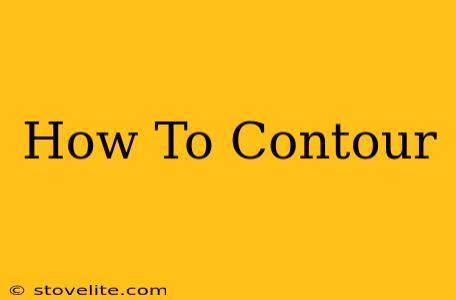Contouring. The word itself might conjure images of Instagram filters and heavily made-up faces, but the reality is far more approachable. Contouring is simply a makeup technique used to enhance your facial features and create a more defined, sculpted look. Whether you're a complete beginner or looking to refine your skills, this guide will walk you through the process step-by-step.
Understanding the Basics of Contouring
Before you even pick up a brush, understanding the basic principles is key. Contouring relies on the interplay of light and shadow. We use darker shades to create shadows, thus receding certain areas of the face, and lighter shades (highlighter) to bring areas forward. This creates the illusion of dimension and structure.
Key Areas for Contouring:
- Temples: Applying contour here can slim the appearance of a wider forehead.
- Hollows of the Cheeks: This is the most common contouring area. It helps to define cheekbones and create a more sculpted look.
- Jawline: Contouring along the jawline can create a more defined and sharper jawline.
- Nose: Contouring the sides of the nose can make it appear slimmer.
Choosing the Right Products
The key to successful contouring isn't just technique, but also selecting the right products. You'll need:
- Contour Product: This can be a powder, cream, or stick. Powder is generally best for beginners due to its ease of blending. Cream contours offer a more natural, dewy finish, while sticks provide precise application. Choose a shade 2-3 shades darker than your foundation.
- Foundation/BB Cream: To create an even base before contouring.
- Highlighter: To add brightness and lift to the face.
- Blending Brush: A fluffy brush is essential for seamlessly blending the contour into your skin. A smaller brush is helpful for precise application, such as around the nose.
- Setting Powder (Optional): To set your makeup and prevent smudging.
Step-by-Step Contouring Tutorial
Step 1: Prep Your Skin: Start with a clean, moisturized face. Apply your foundation or BB cream evenly across your face.
Step 2: Identify Your Face Shape: Understanding your face shape (oval, round, square, heart, etc.) will guide where you should focus your contouring efforts. There are specific contouring techniques for each face shape. Numerous online resources can help you identify yours.
Step 3: Apply the Contour: Using your chosen contour product and brush, apply the contour to the areas mentioned above (temples, hollows of the cheeks, jawline, and nose if desired). Use light, short strokes.
Step 4: Blend, Blend, Blend: This is the most crucial step! Use gentle, circular motions to blend the contour seamlessly into your foundation. Avoid harsh lines. The goal is a natural, shadowed effect.
Step 5: Apply Highlighter: Use a highlighter on the high points of your face – cheekbones, brow bone, bridge of the nose, and cupid's bow. Blend gently.
Step 6: Set (Optional): Dust a light layer of setting powder over your entire face to set your makeup.
Tips for Perfect Contouring
- Start Slowly: Don't overdo it! Begin with a small amount of product and build up gradually.
- Practice Makes Perfect: Don’t get discouraged if your first attempt isn’t flawless. Practice makes perfect.
- Experiment with Different Products: Find what works best for your skin type and preference.
- Consider Your Lighting: Natural light is best for applying and assessing your contour.
- Watch Tutorials: YouTube is a treasure trove of contouring tutorials. Watching professionals can significantly improve your technique.
Mastering contouring can transform your makeup routine. With practice and the right tools, you can achieve a naturally sculpted and defined look that enhances your unique features. So grab your brushes and get started on your contouring journey!

